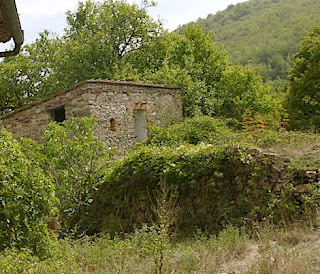 |
| the aia in 2003 |
 |
| similar view in 2012 |
Comparisons
The second photo is a recent view of the restored 'aia' and the old dry stone wall. The 'aia' has been enlarged but we found a portion of its paving stones beneath the brambles and earth. The farmers used to fill the gaps between the paving stones with broken crockery, pottery, any other refuse (which was very little: you didn't waste anything in those days) and manure mixed with straw, which compacted and dried very nicely. What effect it had on the threshed wheat is anyone's guess. The engineer who oversaw our works at Le Ripe wanted to demolish the wall, so that the main house would be more visible. "Over my dead body," was my reply. There are many other dry stone walls on the property, mostly crumbling or covered with earth after decades of neglect. We would love to restore them gradually; the irony is that it is hard to find a builder willing to do the job. Perhaps because it takes longer, because it's a dying skill, or because they really believe that cement lasts longer, as they claim. My response is that the Egyptian pyramids are dry stone and they seem to have lasted pretty well.

No comments:
Post a Comment
Comments are welcome but will be checked before publishing.